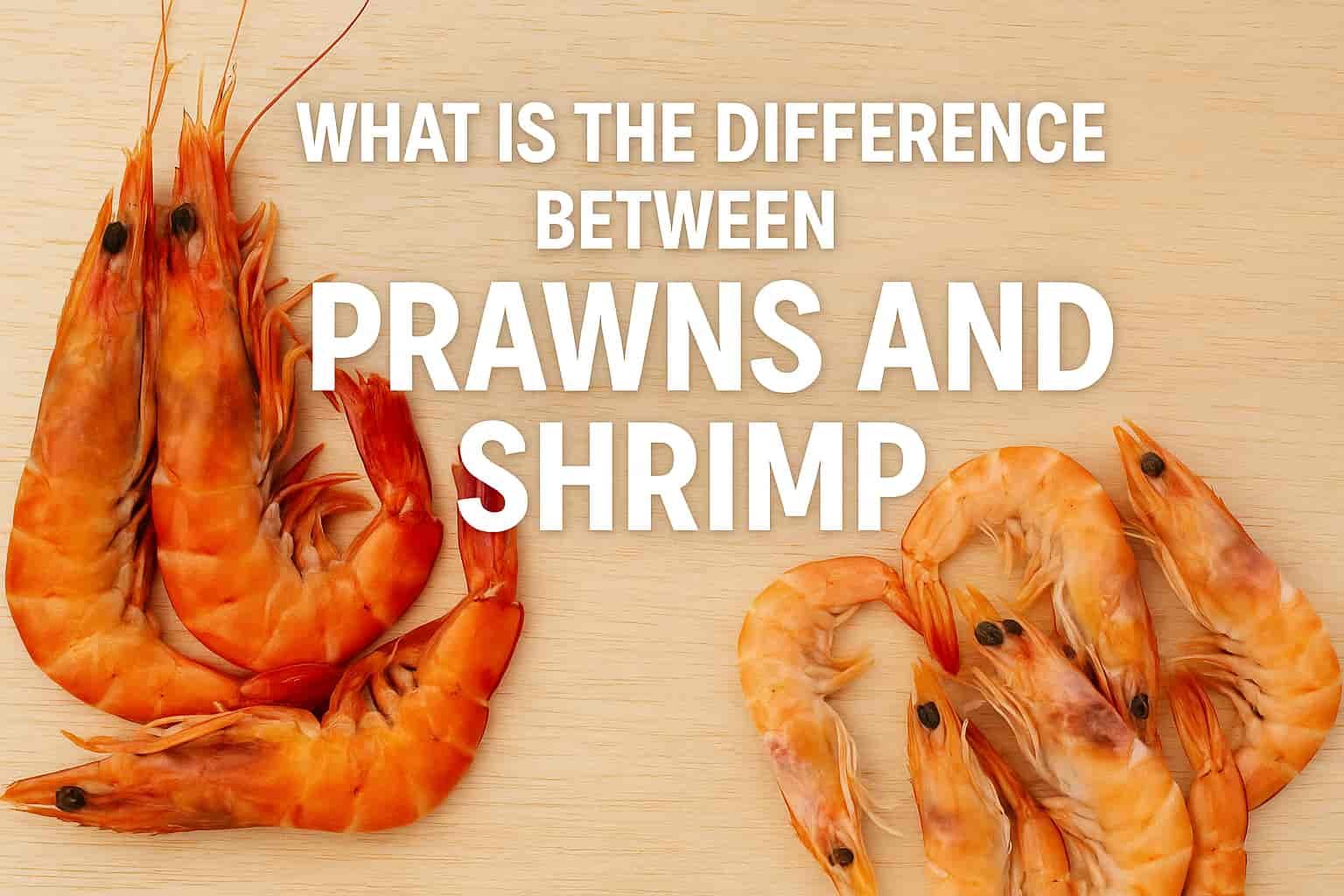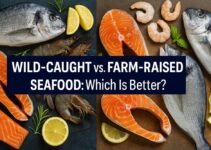Prawns and shrimp are often mistaken for each other, yet they differ in critical biological, culinary, and nutritional aspects. These differences are not a matter of opinion but are based on clear scientific classifications and observable characteristics. Understanding these distinctions helps consumers make informed decisions when purchasing seafood and selecting appropriate ingredients for recipes. This article explains exactly how prawns and shrimp differ, using precise facts and practical examples. By the end of this guide, you will know how to distinguish them at the market, select the right option for your cooking needs, and understand their nutritional impacts.
Contents
- 1 What Is the Scientific Classification of Prawns and Shrimp?
- 2 What Are the Main Physical Differences Between Prawns and Shrimp?
- 3 Where Are Prawns and Shrimp Commonly Found in the Wild?
- 4 How Do Prawns and Shrimp Differ in Taste and Texture?
- 5 What Are the Nutritional Differences Between Prawns and Shrimp?
- 6 How Are Prawns and Shrimp Used Differently in Cooking?
- 7 Which Is More Expensive: Prawns or Shrimp?
- 8 How Can You Easily Tell Prawns and Shrimp Apart at the Market?
- 9 Are There Any Environmental and Sustainability Concerns When Buying Prawns or Shrimp?
What Is the Scientific Classification of Prawns and Shrimp?
Prawns and shrimp belong to different biological suborders, despite both being crustaceans. Prawns fall under the suborder Dendrobranchiata, while shrimp belong to Pleocyemata. This taxonomic classification reflects fundamental anatomical and reproductive differences.
Do Prawns and Shrimp Belong to the Same Biological Suborder?
No, they do not. Prawns are classified under Dendrobranchiata, characterized by branching gills and reproductive habits involving free-floating eggs. Shrimp fall under Pleocyemata, known for their lamellar (plate-like) gills and the practice of carrying fertilized eggs attached to their swimmerets until hatching.
How Does Their Anatomy Differ According to Taxonomy?
Prawns possess three pairs of claw-like legs (chelae), while shrimp have only two pairs. Additionally, prawns have longer legs relative to their body size. Another key difference is the body segmentation: prawns have overlapping plates that run from front to back, whereas shrimp have a distinct bend in their body due to their second abdominal segment overlapping the first and third segments.
What Are the Main Physical Differences Between Prawns and Shrimp?
Prawns are generally larger, with straighter bodies and longer legs, while shrimp tend to be smaller with curled bodies and shorter legs. These physical distinctions make them easy to identify when examined closely.
How Do Their Body Structures and Gills Differ?
Prawns have branching gills resembling tree-like structures, which are more complex and adapted for oxygen absorption in still waters. Shrimp have lamellar gills, appearing as flat plates, suited for faster-moving waters. This difference directly relates to their preferred habitats.
Is There a Size Difference Between Prawns and Shrimp?
Yes. On average, prawns range from 6 to 8 inches long, while shrimp typically measure between 1 to 3 inches. However, this can vary by species. Giant tiger prawns (Penaeus monodon) can reach lengths of up to 12 inches, a size rarely seen in shrimp species.
Where Are Prawns and Shrimp Commonly Found in the Wild?
Prawns are more commonly found in freshwater environments, while shrimp primarily inhabit saltwater regions. Their distribution is influenced by both species adaptation and environmental factors.
Are Prawns Found in Freshwater or Saltwater?
Prawns predominantly inhabit freshwater rivers, lakes, and estuaries. However, some species like the tiger prawn also thrive in brackish waters. In countries such as India, Thailand, and Vietnam, freshwater prawns are farmed extensively due to their market demand.
Which Environments Do Shrimp Typically Inhabit?
Shrimp favor saltwater habitats, including oceans, seas, and coastal regions. Species like the whiteleg shrimp (Litopenaeus vannamei) are common in the Pacific Ocean and are also widely farmed in aquaculture. Shrimp are highly adaptable to various depths, from shallow coastal waters to deep-sea environments exceeding 700 meters.
How Do Prawns and Shrimp Differ in Taste and Texture?
Prawns have a sweeter, more delicate flavor, while shrimp offer a firmer texture and a slightly brinier taste. These distinctions affect their suitability for different cooking methods and recipes.
Which One Is Considered Sweeter or More Delicate?
Prawns are generally preferred for dishes requiring a subtle, sweet flavor. Their natural sweetness makes them ideal for grilling, butter-based sauces, and delicate appetizers. Shrimp, on the other hand, provide a stronger ocean-like taste, which enhances dishes such as shrimp scampi or spicy stir-fries.
How Does Texture Vary Between Prawns and Shrimp?
Prawns have a softer, more tender flesh that cooks quickly, making them suitable for light steaming and poaching. Shrimp possess a firmer texture, maintaining their shape and bite even when sautéed or deep-fried. This is why shrimp are often used in robust recipes like gumbo or tempura, where structural integrity is important.
What Are the Nutritional Differences Between Prawns and Shrimp?
Both prawns and shrimp are low-calorie, high-protein seafood options, but prawns typically offer slightly higher calorie content and more cholesterol per serving.
Which Has Higher Protein Content?
Shrimp contain approximately 24 grams of protein per 100 grams, while prawns provide about 21 grams per 100 grams. Although shrimp have a marginally higher protein concentration, the difference is not nutritionally significant for most diets.
Are There Significant Differences in Cholesterol Levels?
Yes. Prawns have a higher cholesterol content, with approximately 195 mg per 100 grams, compared to 189 mg per 100 grams in shrimp. Despite this, both seafood types remain within acceptable dietary cholesterol limits for healthy individuals. For those managing cholesterol levels, moderation is advised regardless of choice.
How Are Prawns and Shrimp Used Differently in Cooking?
Prawns are often reserved for premium dishes and festive meals, while shrimp are a versatile ingredient found in everyday recipes worldwide.
Which Recipes Are Better Suited for Prawns?
Prawns shine in recipes that highlight their size and sweetness, such as grilled prawns with garlic butter, prawn cocktails, or seafood paella. They are frequently featured in fine-dining menus and celebratory meals due to their visual appeal and luxurious flavor.
Are Shrimp More Common in Certain Regional Cuisines?
Yes. Shrimp are a staple ingredient in American, Mediterranean, and Asian cuisines. Dishes like shrimp tacos, shrimp gumbo, pad Thai, and shrimp fried rice rely heavily on the firm texture and savory taste of shrimp. Their availability and affordability make them a popular choice in everyday cooking across the globe.
Which Is More Expensive: Prawns or Shrimp?
Prawns are generally more expensive than shrimp due to their larger size, sweeter taste, and limited supply. Price differences also depend on whether the seafood is wild-caught or farm-raised.
What Factors Influence Their Market Prices?
The primary factors include species rarity, size, harvesting methods, and demand in fine dining. Wild-caught prawns, especially tiger prawns and king prawns, command premium prices, often exceeding $25 per pound, while common shrimp varieties like whiteleg shrimp average around $12 to $15 per pound. Seasonal availability also affects cost; prices rise during holiday periods when demand peaks.
Are Prawns Considered a Luxury Ingredient?
Yes. Prawns are viewed as a premium seafood choice, frequently featured in gourmet dishes and upscale restaurants. Their impressive size and presentation value make them ideal for luxury appetizers and main courses, reinforcing their reputation as a high-end ingredient.
How Can You Easily Tell Prawns and Shrimp Apart at the Market?
You can distinguish prawns from shrimp by examining their size, body structure, and leg count. These physical traits are consistent across species and are reliable identification methods.
What Are the Key Visual Cues to Identify Them?
Prawns typically have longer, straighter bodies and three pairs of claw-like legs (chelae). Their second abdominal segment overlaps the third, giving their body a smooth, linear appearance. Shrimp display a pronounced curve in their bodies, have only two pairs of chelae, and their second abdominal segment overlaps both the first and third segments, creating a noticeable bend.
Are There Labeling Standards for Differentiation?
In the United States and Canada, seafood labeling is not always consistent, and the terms “prawns” and “shrimp” are sometimes used interchangeably. However, in markets adhering to strict labeling standards—such as those in Australia and the United Kingdom—prawns and shrimp are clearly differentiated based on species and size classifications. When in doubt, check for the scientific name or ask the vendor directly.
Are There Any Environmental and Sustainability Concerns When Buying Prawns or Shrimp?
Yes, both prawns and shrimp raise sustainability concerns, particularly related to overfishing, habitat destruction, and the environmental impact of aquaculture. Choosing responsibly sourced seafood helps protect marine ecosystems and supports sustainable fishing practices.
Which Is More Sustainable: Wild-Caught or Farm-Raised?
Wild-caught shrimp often contribute to bycatch and habitat damage through trawling methods. Conversely, poorly managed shrimp and prawn farms can lead to water pollution and destruction of coastal ecosystems such as mangroves. The Aquaculture Stewardship Council (ASC) and Marine Stewardship Council (MSC) certify seafood that meets strict sustainability standards. Look for these certifications to ensure responsible sourcing.
How Can Consumers Make Environmentally Friendly Choices?
Choose certified sustainable seafood, prioritize locally sourced options to reduce carbon emissions, and select species known for lower environmental impact, such as whiteleg shrimp (Litopenaeus vannamei) farmed under responsible practices. Additionally, avoid purchasing oversized tiger prawns from uncertified farms, as these often involve unsustainable practices.
By understanding these differences and making informed purchasing decisions, consumers can enjoy seafood responsibly without contributing to environmental degradation. For further guidance on making sustainable seafood choices, refer to our detailed guide: How to Choose Fresh Seafood at the Market.



